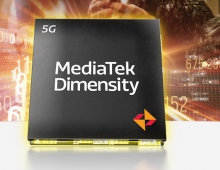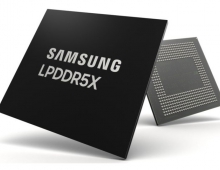
MediaTek Unveils 10-core Xelios X20 Chip For Mobile Devices
Taiwan's MediaTek on Tuesday, announced its Helios X20 a mobile processor with 10 cores that it can offer better power efficiency and improved performance over competing processors, according to the company. The mobile processor has a "Tri-Cluster" CPU architecture and ten processing cores (Deca-core). Essentially, this configuration is packing together a dual-core chip with a pair of quad-cores. It provides three processor clusters, each designed to more efficiently handle different types of workloads. The dual-core cluster, which uses two ARM Cortex-A72 2.5 GHz processors, is meant to handle the most intensive tasks. The pair of quad-core clusters are designed for medium and lower-scale computing.
MediaTek claims this configuration can help save 30 percent on battery life over traditional chips, while keeping the phone's software running smoothly.
The Helios X20 will launch in December, and is designed for top-of-the-range smartphones.
Mediatek also launched its eight-core chip in 2013, but weeks later Qualcomm called such processors "dumb." Later, though, Qualcomm, took a step back from that remark, and began offering its own eight-core chips.
MediaTek's Helios X20 will be built with a 20-nanometer manufacturing process, and can operate two dual cameras with built-in 3D depth engine, plus multi-scale de-noise engines, in the back of a phone.
The Helio X20 refreshes smartphone displays at an accelerated 120Hz per second. A low power sensor processor ? ARM Cortex-M4 supports diverse always-on applications such as MP3 playback and voice activation. The sensor hub on the embedded ARM Cortex-M4 processor operates on an isolated, low-power domain to support diverse always-on applications such as MP3 playback and voice activation.
The SoC also has a modem for 4G LTE FDD/TDD and 3G bands.
| helio X10 | helio X20 | |
|---|---|---|
| Process | 28mm HPM | 20mm |
| Apps CPU | 8x Cortex-A53, up to 2GHz | Industry Leading Tri-Cluster 10-core Architecture |
| Memory | 2x LPDDR3 POP 800MHz up to 4GB eMMC 5.0 |
Industry Leading Tri-Cluster 10-core Arhcitecture |
| Camera | 21MP @ 30fps w / ZSD DUal ISP |
32MP @ 24fps / 25MP @ 30 fps w/ZSD DUal ISP w/Improved 3A/denoise / demonsalc/sharpness/Native3D |
| Video Decode | 4Kx2K 30fps H.264/265 | 4Kx2K 10 bit 30fps H.264/265/VP9, 30% power improvement |
| Video Encode | 4Kx2K 30fps H.265 | 4Kx2K 30fps H.265 w/HDR, 40% power improvement |
| Graphics | IMG G6200 700 MHz | ARM Mail-T880 MP4 700MHz, 40% more performance |
| Display | WQXGA 2560x1600 60fps FHD 1920x1080 120fps w/8 HW Blending Layer |
WQXGA 2560x1600 60fps FHD 1920x1080 120fps w/12 HW Blending Layer |
| Modem | LTE FDD/TDD R9 Cat4 (150/50Mbps) DC-HSPA+,TD-SCDMA,EDGE |
LTE FDD/TDD R11 Cat-6 with 20+20 CA (300/50Mbps) DC-HSPA+, TD-SCDMA,EDGE CDMA2000 1x/EVDO Rev.A (SRLTE) LTE/GPS Co-clock Supported |
| RF | Single RF for LTE/WCDMA/TD/EDGE 8/8 Primary/Diversity RX Ports |
Single RF for LTE/WCDMA/TD/EDGE/C2K 14/14 Primary/Diversity RX Ports |
| Connectivity | External Wi-Fi 802.11ac (MT6630) GPS//Glonass/Beidou, BT/FM |
Integrated Wi-Fi 802.11ac w/throughout up to 280Mbps GPS/Glonass/Beidou w/ Improved TTFF & Drift, BT/FM |





















